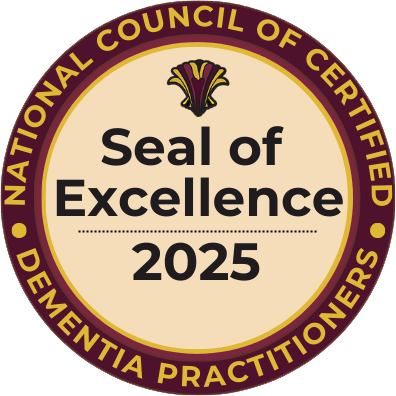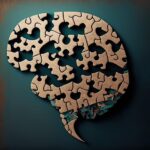Untreated vision loss increases dementia risk factors; in fact, JAMA statistics show that nearly 20% of preventable dementia could be due to vision impairment.
This article follows the outline in the NCCDP in-service presentation “Vision Loss and Dementia” and expands it with current evidence and practical steps for care teams.
Why This Link Matters
Vision loss and dementia frequently co-occur in late life. In 2024, the Lancet Commission added untreated vision loss to its list of modifiable dementia risk factors, updating its prevention model to 14 factors that together might delay or prevent a substantial share of cases globally (Livingston et al., 2024). Complementing this, a 2024 JAMA Ophthalmology analysis estimated that ~5%–19% of prevalent dementia among U.S. adults ≥71 could be statistically attributable to one or more measurable vision impairments—especially reduced contrast sensitivity (Smith et al., 2024). Bottom line: protecting and rehabilitating sight is not just about vision; it’s brain-health policy.
What The Research Shows
- Associations are consistent overall. Meta-analyses link vision impairment with higher odds of cognitive impairment and dementia across cohorts and measures (Shang et al., 2021).
- Effect sizes vary by measure and design. Some long follow-ups find weaker or mixed associations for visual acuity alone, highlighting the importance of contrast sensitivity and comprehensive testing (van Boxtel et al., 2024).
- Treatable eye disease matters. Older adults who undergo cataract extraction show a lower subsequent risk of developing dementia in large observational cohorts (Lee et al., 2022).
Why Vision And Cognition Are Connected
Multiple pathways likely interact:
- Reduced sensory input → less cortical stimulation and diminished cognitive reserve (Livingston et al., 2024; Alzheimer’s Association, 2025).
- Functional & social consequences → isolation, depression, lower activity—each tied to cognitive decline (Alzheimer’s Association, 2025).
- Shared risks → vascular/metabolic disease raises risk for both eye disease and dementia (van Boxtel et al., 2024).
Common Visual–Cognitive Errors You’ll See In Practice
Care teams routinely observe: misidentifying objects, difficulty recognizing faces, depth-perception problems, and color/contrast confusion—all of which can be driven by eye disease, dementia-related visuospatial changes, or both. These patterns align with the in-service outline and should trigger a vision review rather than assumptions about “behavior.”
Conditions that commonly drive late-life vision lossLeading causes in older adults include age-related macular degeneration, cataract, diabetic retinopathy, and glaucoma. Many are detectable early and respond to treatment or rehabilitation (National Eye Institute [NEI], 2025; Centers for Disease Control and Prevention [CDC], 2024).
Assessment: Build Vision Into Dementia Care
- Ask better questions. “Any trouble with glare, contrast, or steps?”—not just “Do you wear glasses?” (Smith et al., 2024; NEI, 2025).
- Test what matters. If available, include contrast sensitivity, which is often more predictive than distance acuity for function (Smith et al., 2024).
- Refer early and often. Ophthalmology for disease; optometry for refraction; low-vision rehabilitation for maximizing remaining sight (NEI, 2025).
What Helps: Evidence-Based Interventions
- Correct what’s correctable. Update prescriptions; treat cataracts (consider surgical evaluation); optimize glycemic and vascular risks for diabetic retinopathy and glaucoma. Association studies suggest cataract surgery is linked with reduced dementia risk (Lee et al., 2022).
- Low-vision rehabilitation works. Studies show gains in reading ability, quality of life, and depression reduction, including via telerehabilitation (Liu et al., 2025; Occupational Therapy Telerehabilitation Review, 2025).
- Design for perception (environmental tuning). Bright non-glare lighting; high-contrast edges (stairs, grab bars, plates/placemats); decluttered pathways; large-print labels and tactile cues; verbal orientation during tasks (NEI, 2025; National Council of Certified Dementia Practitioners [NCCDP], n.d.).
- Maintain engagement. Favor tactile and auditory activities (music, textured crafts, guided movement) and supported social interaction to counter isolation (Alzheimer’s Association, 2025; NCCDP, n.d.).
Implementation Playbook For Memory Care & Clinics
- Protocolize screening. Add a 60-second vision check (glasses on/off; glare/contrast questions; check lighting). Document and track (NEI, 2025).
- Build a referral loop. Know local ophthalmology/optometry/low-vision specialists; schedule annual dilated exams for residents ≥65 or anyone with diabetes, glaucoma risk, or functional red flags (NEI, 2025; CDC, 2024).
- Standardize environmental audits. Quarterly walk-throughs: luminance checks, contrast tape on hazards, glare reduction, signage legibility (NEI, 2025).
- Train the team. Teach staff to distinguish cognitive versus perceptual errors; when in doubt, assume a vision component and adjust supports first (Livingston et al., 2024; NCCDP, n.d.).
Key Takeaways
- Vision loss is now a recognized, modifiable risk factor for dementia at the population level (Livingston et al., 2024; Smith et al., 2024).
- Practical steps—treatment, rehabilitation, and environment design—improve function and may lower risk signals (Lee et al., 2022; NEI, 2025; Liu et al., 2025).
- Integrating vision care into dementia pathways is a high-value, immediately actionable strategy for quality of life and safety (NEI, 2025; CDC, 2024).
References:
Alzheimer’s Association. (2025). Alzheimer’s disease facts and figures. Alzheimer’s & Dementia (Special Report).
Centers for Disease Control and Prevention. (2024). Vision loss: Fast facts. U.S. Department of Health and Human Services.
Lee, C. S., Gibbons, L. E., Lee, A. Y., et al. (2022). Association between cataract extraction and development of dementia. JAMA Internal Medicine, 182(12), 1349–1356.
Liu, X., et al. (2025). The effect of low-vision rehabilitation on quality of life and caregiver burden: A systematic review. [Peer-reviewed study].Livingston, G., et al. (2024). Dementia prevention, intervention, and care: 2024 report of the Lancet Commission. The Lancet.
National Council of Certified Dementia Practitioners. (n.d.). NCCDP in-service toolkit: Vision loss and dementia.
National Eye Institute. (2025). Low vision. National Institutes of Health.
Shang, X., Zhu, Z., Wang, W., Ha, J., & He, M. (2021). The association between vision impairment and incidence of dementia and cognitive impairment: A systematic review and meta-analysis. Ophthalmology, 128(8), 1135–1149.
Smith, J. R., Huang, A. R., Zhou, Y., Varadaraj, V., Swenor, B. K., Whitson, H. E., Reed, N. S., Deal, J. A., & Ehrlich, J. R. (2024). Vision impairment and the population attributable fraction of dementia in older adults. JAMA Ophthalmology.
van Boxtel, M. P. J., et al. (2024). Associations of hearing and visual loss with cognitive decline and dementia risk: A 25-year follow-up of the Maastricht Aging Study. Aging & Mental Health.























